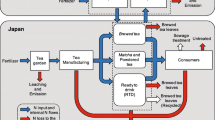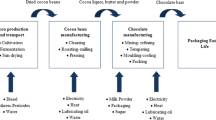Abstract
Purpose
Following water, tea is the second most consumed drink worldwide and has the peculiarity that not only its production but especially its preparation can be associated with considerable greenhouse gas (GHG) emissions. The aims of this study were to calculate the cradle-to-gate and cradle-to-grave product carbon footprint (PCF) of Darjeeling tea and to identify potentials to reduce GHG emissions along its life cycle. Therefore, various options for action and their impact on the PCF were modeled by using a scenario analysis.
Methods
To assess the PCF of Darjeeling tea, the method based on ISO/TS 14067 was used with some limitations. Besides one base scenario, alternative cradle-to-gate scenarios and different use profiles were modeled. The results were split in a cradle-to-gate and a cradle-to-grave perspective. For the cradle-to-gate phase a functional unit of one kilogram loose black Darjeeling tea was chosen, whereas for the cradle-to-grave phase one liter black Darjeeling tea that is prepared and ready to drink in Germany was seen as appropriate functional unit. Primary data for the present study has been collected from local farmers, manufacturers, and agents in Darjeeling, Kolkata, and Rotterdam. For secondary data, the database ecoinvent 2.2 was mainly used.
Results and discussion
The cradle-to-gate PCF of 1 kg Darjeeling tea is between 7.1 and 25.3 kg CO2e depending on the cultivation method, energy sources used, or mode of transportation. The cradle-to-grave PCF for 1 l organic Darjeeling tea is about 0.15 kg CO2e. The largest share, 51 %, makes up the use phase, which is clearly dominated by the boiling of water. The variety of possible use profiles yields results of great breadth. It shows that the life cycle of organic Darjeeling tea transported by ship, depending on the preparation variants can cause emissions from 0.12 to 0.51 kg CO2e/l tea.
Conclusions
The main reduction potentials for GHG emissions were identified in the process of water boiling, the intercontinental transport mode, and the cultivation method. Since the climate impact of tea strongly depends on the way in which it is prepared, the consumer has a decisive influence on the PCF. Therefore, in order to make a reliable statement about the climate performance of consumer goods such as tea, the whole life cycle must be considered.




Similar content being viewed by others
References
Beutgen M (2012) Tee ist das beliebteste Getränk der Welt. Deutscher Teeverband e.V, Hamburg
BGK BHE (2004) Informationsdienst Humuswirtschaft & KomPost 3/04. Koeln, Germany
BMELV (2009) Report on active climate protection in the agriculture, forestry and food industries and on adaptation of agriculture and forestry to climate change, September 2008 [online]
Brita Gruppe (2012) Nachhaltigkeitsbericht 2012. Taunusstein
BSI (2008) PAS 2050:2008 Publicly available specification for the assessment of the life cycle greenhouse gas emissions of goods and services. British Standards Institution, London
BSI (2011) PAS 2050:2011 Publicly available specification for the assessment of the life cycle greenhouse gas emissions of goods and services. British Standards Institution, London
BSI (2012) PAS 2050-1:2012 Assessment of the life cycle greenhouse gas emissions from horticultural products. Supplementary requirements for the cradle to gate stages of GHG assessments of horticultural products undertaken in accordance with PAS 2050. British Standards Institution, London
Busser S, Jungbluth N (2009) The role of flexible packaging in the life cycle of coffee and butter. Int J Life Cycle Assess 14(1):80–91
de Monte M, Padoano E, Pozzetto D (2005) Alternative coffee packaging: an analysis from a life cycle point of view. J Food Eng 66:405–411
Doublet G, Jungbluth N (2010) Life cycle assessement of drinking Darjeeling tea. Conventional and organic Darjeeling tea. ESU-services Ltd., Uster
EC-JRC - European Commission - Joint Research Centre and Institute for Environment and Sustainability (2010) International reference life cycle data system (ILCD) handbook—general guide for life cycle assessment—detailed guidance, European Union EUR24708., http://lct.jrc.ec.europa.eu/
ecoinvent Centre (2010) ecoinvent data v2.2. ecoinvent reports No. 1-25. Swiss Centre for Life Cycle Inventories, Duebendorf, Switzerland
EPA (2012) Composting. http://epa.gov/climatechange/wycd/waste/downloads/Composting.pdf. Accessed 19.08.2013
Hassard HA, Couch MH, Techa-erawan T, McLellan BC (2014) Product carbon footprint and energy analysis of alternative coffee products in Japan. J Cleaner Prod 73:310–321
Humbert S, Loerincik Y, Rossi V, Margni M, Jolliet O (2009) Life cycle assessment of spray dried soluble coffee and comparison with alternatives (drip filter and capsule espresso). J Cleaner Prod 17(15):1351–1358
IPCC (2006a) Volume 4. Agriculture, forestry and other land use. Chapter 11. Guidelines for National Greenhouse Gas Inventories. Intergovernmental Panel on Climate Change, Geneva, Switzerland
IPCC (2006b) Volume 5. Waste. Chapter 4. Guidelines for National Greenhouse Gas Inventories. Intergovernmental Panel on Climate Change, Geneva, Switzerland
IPCC (2007) Climate Change 2007: Synthesis Report. Contribution of Working Groups I, II and III to the Fourth Assessment Report of the Intergovernmental Panel on Climate Change. [Core Writing Team, Pachauri, R.K. and Reisinger, A. (eds.)]. Fourth Assessment Report IPCC, Geneva, Switzerland
ISO (2013) ISO/TS 14067: Greenhouse gases–carbon footprint of products—requirements and guidelines for quantification and communication. International Organization for Standardization, Geneva
Jungbluth N (2006) Vergleich der Umweltbelastungen von Hahnenwasser und Mineralwasser. Gas, Wasser, Abwasser 2006(3):215–219
Jungbluth N, Chudacoff M, Dauriat A, Dinkel F, Doka G, Faist Emmenegger M, Gnansounou E, Kljun N, Schleiss K, Spielmann M, Stettler C, Sutter J (2007) Life cycle inventories of bioenergy. ecoinvent report No. 17. Swiss Centre for Life Cycle Inventories, Duebendorf, Switzerland
Linzner R, Mostbauer P, Binner E, Smidt E (2005) Klimarelevanz der Kompostierung unter Berücksichtigung der Verfahrenstechnik und Kompostanwendung (KliKo). Endbericht im Auftrag der MA 48. Institut für Abfallwirtschaft, Universität für Bodenkultur Wien, Vienna, Austria
Oberascher C, Stamminger R, Pakula C (2011) Energy efficiency in daily food preparation. Int J Consumer Studies 35:201–211
Quack D, Rüdenauer I (2005) Stoffstromanalyse relevanter Produktgruppen. Energie- und Stoffströme der privaten Haushalte in Deutschland im Jahr 2005 [online]
Schmied M, Knörr W (2011) Berechnung von Treibhausgasemissionen in Spedition und Logistik: Begriffe, Methoden. Beispiele. Deutscher Speditions- und Logistikverband, Bonn
Stiftung Warentest (2006) Wasserkocher: Viele schlechte Noten, http://www.test.de/Wasserkocher-Viele-schlechte-Noten-1401054-2401054/. 2013
Teufel J, Brommer E, Stratmann B (2011) Grobscreening zur Typisierung von Produktgruppen im Lebensmittelbereich in Orientierung am zu erwartenden CO2e-Fußabdruck - Materialband. LANUV-Fachbericht 29. Recklinghausen, Germany
Umweltbundesamt (2014) ProBas - Prozessorientierte Basisdaten für Umweltmanagement-Instrumente. http://www.probas.umweltbundesamt.de/php/themen.php?&prozessid={112E951E-0C6D-4C2F-B404-C393B35F089A}&id=4584374272&step=4&search=. Accessed 20.01.2014
WRI/WBCSD (2011) Greenhouse gas protocol–product life cycle accounting and reporting standard. World Resources Institute and World Business Conucil for Sustainable Development, Washington
Acknowledgments
We gratefully acknowledge the German Federal Ministry of Education and Research (BMBF) for the funding of the project “Unternehmensvorteile durch Umweltmanagement entlang der Wertschöpfungskette und durch Verbraucherinformation - Chancen und Rahmenbedingungen für die Bestimmung und die Kommunikation des CO2-Fußabdrucks von Produkten, insbesondere für kleine und mittlere Unternehmen” under the “FHprofUnt” funding line (grant no. /FKZ: 17022B10/17022C10). We would also like to thank our project partner Projektwerkstatt, Gesellschaft für kreative Ökonomie mbH, Potsdam (Teekampagne) for the fruitful cooperation and the provision of information and data. The authors also acknowledge the constructive comments received by the anonymous reviewers.
Author information
Authors and Affiliations
Corresponding author
Additional information
Responsible editor: Adriana Del Borghi
Electronic supplementary material
Below is the link to the electronic supplementary material.
ESM 1
(DOCX 41 kb)
Rights and permissions
About this article
Cite this article
Cichorowski, G., Joa, B., Hottenroth, H. et al. Scenario analysis of life cycle greenhouse gas emissions of Darjeeling tea. Int J Life Cycle Assess 20, 426–439 (2015). https://doi.org/10.1007/s11367-014-0840-0
Received:
Accepted:
Published:
Issue Date:
DOI: https://doi.org/10.1007/s11367-014-0840-0




